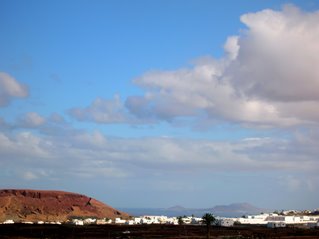Taking to the roads
Roads are up at the moment, all over the island; local roads and main roads alike. Why all at once asks Granny? Silly her. The local elections are next year and those in office have to do something to suggest they have done more than fill their pockets for the past five years. Some of these 'caminos cortados' are kind enough to suggest alternative routes. Some aren't. Meaning that the dithering tourists dither more than ever, making the dangerous delights of driving round this island even more so. And even more circuitous.
But at least the big road closed for last weekend's festival is open again. Which means too that you are no longer liable to run down the pilgrims dressed in local dress who walked from every end and corner of the island to reach it; some of them starting several days before. The festival is a pilgrimage celebrating the local 'Nuestra Senora de las Dolores' - our Lady of the Sorrows to you - she doesn't sound a likely origin of such a major jolly, but so she is. And all because in 1824 she is said to have answered the prayers of those threatened by yet another erupting volcano and stopped the lava short, saving a village or two thereby and all its crops. And now she's celebrated by people from across the Canaries. Each year more so; hence this year the party that wasn't. Granny and Beloved living just down the road from the pilgrimage church have over the past year or two invited friends to a barbecue in the evening. This year only one lot -who knew the area well enough to wriggle around the 100 detours - made it. They faced an awful lot of food for five people. Most of it ended up in the freezer. But there you go.
But the festival itself was delicious. It always is. It has nothing whatever to do with tourists who hardly know that it is on. Imagine a cross between a harvest festival, a procession, a funfair, the Canarian equivalent of a morris dancing fest, an English village gala and general piss-up. Waving your beer can to greet the Virgin seems a perfectly acceptable greeting. The whole thing is one of those weird alliances between the genuinely holy and the stupendously tacky that only Hinduism and Catholicism know how to produce. Take the moment the image of Dolores is rolled from the church; there she comes, crowned, beneath her silver arch, surrounded by flowers, robed in black and silver; there is the priest saying prayers; there is the tinned choir singing anthems - it is a heart-stopping moment; really. At the same time the fair-ground carries on at full belt. Round and round goes the whip machine, surmounted by a huge - twice the size of Dolores - plastic image of Mr Incredible, throwing out its grinding tin music, throwing out shrieks of pleasure and panic from those sitting in the seats, their ethnic skirts flying up, their ethnic hats flying off.
And then the pilgrims come; led by Amigos de Caballos on those beautiful Spanish horses, some of whose riders know how to perform elaborate high school movements, some of whom - finding it hard to control their steeds at all - don't. They come with carts, ships, model volcanoes, model Canarian farmhouses, model churches, model townhalls, full of gifts and produce, pulled or pushed by donkeys, shetland ponies, mules - camels sometimes though not this year - by tractors, big and small, by groups of people. They come with groups of singers and dancers from this island and from others. They bring baby buggies, wheelbarrows, supermarket trolleys laden with stuff, from every township, village, hamlet on the island. (Sometimes the baby buggies come complete with babies. Granny doesn't think they are on offer, human sacrifice to the Goddess - for Goddess Dolores is - would not appear to be de rigueur - unless you count possible accidents from the dodgier fairground rides.) A full-sized model of an altar, complete with lace altarcloth, flowers, candles and a chalice pulled by one reverent group was followed by a man carrying on his shoulder a 30 kilo pumpkin. Everything was announced in the same excited tone of voice by the local-town-costumed master of ceremonies, a radio presenter; the entire performance, as every year, going out live on local radio and television. Hence the nests of cables, the cameras, the microphones wielded by swarms of technicians not clad in local dress, aside from a hat or two, unlike the more glamorous presenters.
The arrival of the pilgrims lasts for hours each year, well into the night. The fair and the much more sedate handicrafts fair behind go on for three or four days, as do the entertainments, folkloric and not - local comedians, local rock-groups - and so forth. But only on pilgrimage day do the islanders turn out in local dress. Only on pilgrimage day are they televised.
Granny does not turn out in local dress; heaven forfend. But she loves it all. Last year she had an unavoidable date with a surgeon, so had to miss it. Not this year. She and Beloved went back the following evening for the climax of the festival - a magnificent firework display, culminating in a firework church surmounted by a cross; tackiness plus holiness all over again. The only problem; the Spanish and the Canarians do not think fireworks are fireworks without loud - very loud - bangs. Granny takes earplugs when she remembers.
No, silly her, she forgot to take a camera. Sorry about that.







0 Old comments:
<< Home